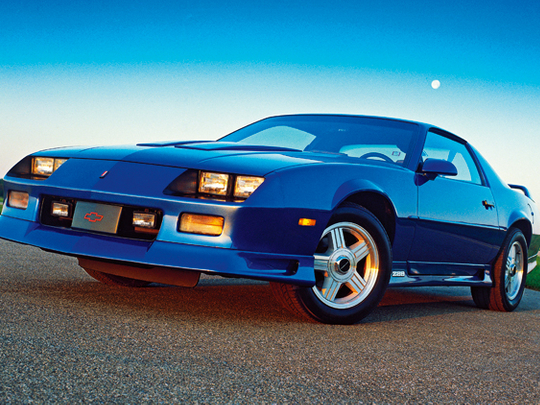
You’re probably well aware of my deep-rooted love (OK, obsession) for a certain car — the Pontiac Firebird Trans Am. I’ve got a GTA that not only demands all of my attention, but it takes all of my money too. I’d like nothing more than to tell you all about this classic (ignore Dejan’s inverted commas in issue 355…). Instead, its almost identical twin, the Chevrolet Camaro, gets my attention this week.
These two GM muscle machines were basically the same car with different front and rear ends. Though it’s widely accepted that the second generation models were the kings of the road, these third gens are finally getting the praise they deserve from classic car circles and are fast becoming collector items. I’m, as you’d imagine, delighted by this.
When they hit the streets back in the early Eighties, it took time for fans of the breed to warm to them. Not because they weren’t good examples of American muscle — they were. But anything after those hugely popular second-generation cars would have struggled to make a favourable impression. It was a tough act to follow but as the decade progressed, so did the cars right up until the last ones rolled of the Van Nuys plant, California, in 1992.
GM totally redesigned the car in 1982. It still used the F-body platform but not only was it around 230kg lighter, it had taken some impressive technological strides that were forced on it. Due to the 1979 oil crisis that hit the US hard, GM implemented fuel saving techniques to its cars. Camaros could now be had with fuel injection and a four-cylinder motor for the first time. However, these were absolutely gutless and would probably struggle to roll down hill what with just 90bhp under the bonnet…
Enthusiasts demanded more power and though they got it, it was nothing close to the figures of those fire-breathing monsters of yesteryear. Those beasts would shred the rear rubbers if you merely thought about touching the throttle let alone burying it. But third gens, riding on those classic 16in alloys and with a full body kit, looked brutal and became the talk of the town.
Three trims were available back then; the Sport Coupe, Berlinetta and the Z28, which boasted the biggest engine in the line up, the 5.0-litre (305 cubic inch) V8. This unit could be had with either a four-speed manual or three-speed auto and produced 165bhp. It was chosen as the Indy 500 Pace Car for that year and replicas were quickly produced with special silver and blue paint scheme, four-colour body striping, Indy 500 door decals, blue cloth/silver vinyl interior and red pinstripes on the aluminium wheel. They looked an absolute treat and became the cars you just had to be seen in.
The 1987 20th anniversary Camaros saw a big improvement in performance and that was thanks to the fabulous 5.7-litre (350 cubic inch) tuned port injection V8 mated to a four-speed auto. It was mostly hard top cars that were fitted with this drivetrain, it was deemed too strong for t-top body styles as these tended to twist and buckle over time. The other big news for the ’87 model year was the return of the convertible, which hadn’t been seen since 1969. It looked like a winner.
1992 was the end of the road for both the third-gen Camaro and Firebird. Chevy planned to go out with a bang by offering a 25th Anniversary Heritage Edition. These cars were to be fitted with cylinder heads, exhaust headers and six-speed manuals from the same model year Corvettes but the plan was scrapped at the last minute. Instead, all they got were graphics, badges and rally stripes. But by now, the 5.7-litre V8s had been fine tuned to produce 240bhp and 470Nm of torque. It was more than enough to launch them up the road with the wheels pleading for life; 100-ft burnouts never looked so good. I should know — my GTA has that very engine. And yes, I do spend a ton on tyres.
Blue beauty! Third-gen Camaros are fast becoming collectors’ items











